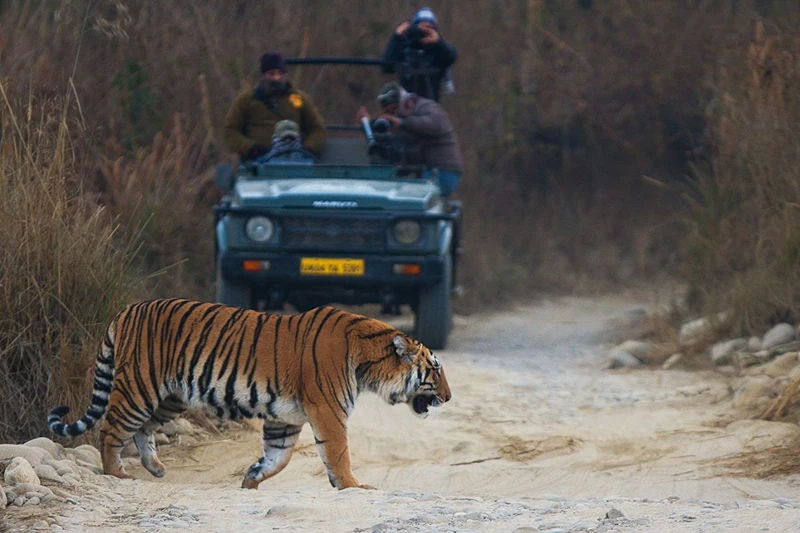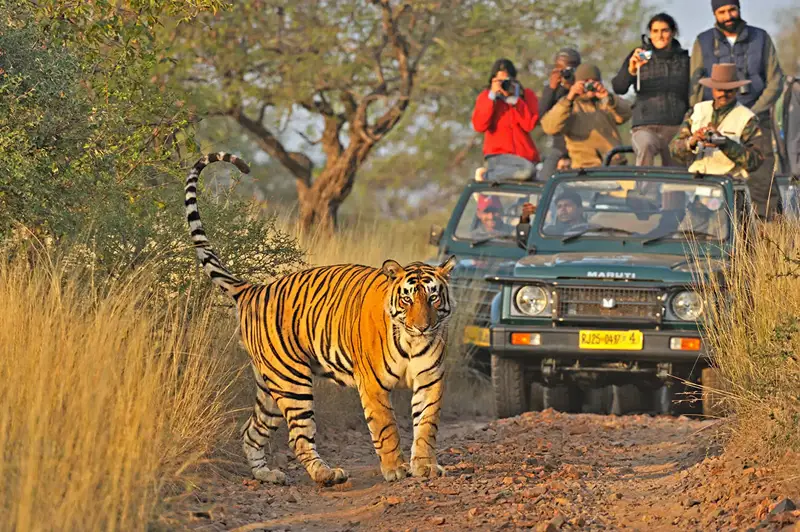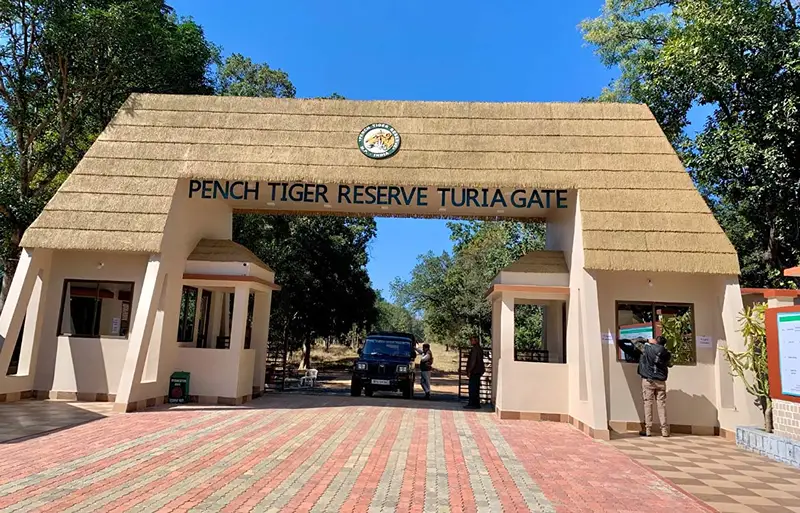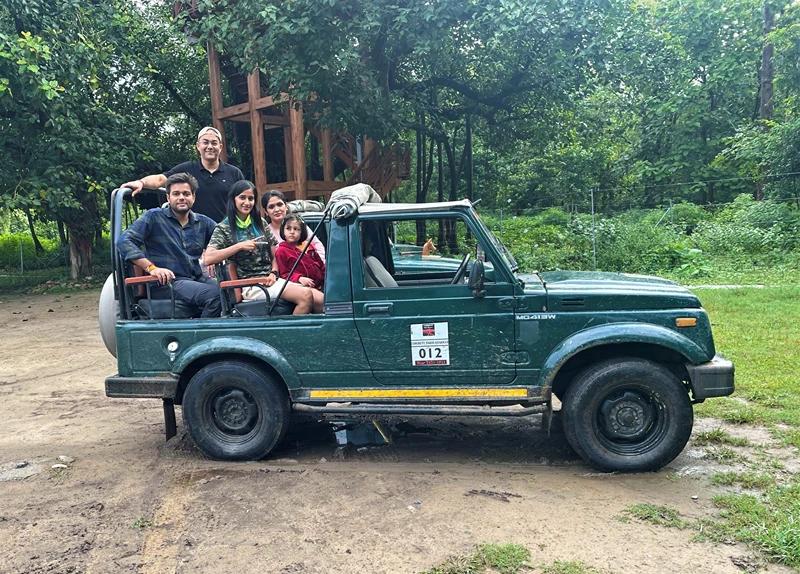

India is home to some of the world’s most spectacular wildlife reserves. And among the standouts of Wildlife Safari India are Ranthambore in Rajasthan, Pench in Madhya Pradesh/Maharashtra, and Jim Corbett in Uttarakhand. What makes each of these different is the blend of varied landscapes, different flora & fauna, distinct cultural surroundings, and safari styles. This blog dives deep into
what makes them special, when to go, and how to make the most of your trip.

What’s Special
Known to be one of India’s most famous tiger reserves, the landscape of Ranthambore has dry deciduous forest, rocky outcrops, lakes, and ruins. It was a former royal hunting ground and fortress (Ranthambore Fort) gives it a dramatic backdrop.
Beyond tigers, Ranthambore Safari India also has a good variety of wildlife such as sloth bears,
leopards, jackals, hyenas, deer and birds.
When to Visit
The park stays open from October to June (closed during monsoon) while the best time for tiger sightings tends to be March-May, when foliage is less dense and animals come to waterholes more often. Winter, October-February is quite pleasant for weather and birding.
Tips for a Better Experience
For the best light and more active wildlife, prefer morning safaris.
Take binoculars/good zoom camera as you’ll most likely see birds, deer etc even if you don’t see a tiger immediately.
Staying in nearby Sawai Madhopur or in a forest lodge can help you get early access.

What’s Special
Among the best places to visit in Madhya Pradesh, Pench lies on top, straddling the border of
Madhya Pradesh and Maharashtra, which gives you options depending on where you enter. With teak
and sal forests, meadows and rivers covering most of the landscape, the wildlife includes tigers, wild dogs, leopards, sloth bears, deer, and a multitude of bird species.
When to Visit
Safari season in Pench usually opens around mid-October and runs until about end of June, and stays closed during monsoon for safety & breeding.
Best months: post-monsoon (October-November) when forest is lush and waterholes are still full, plus winter months when wildlife moves more visibly.
Tips
Use Turia Gate (MP side) if possible to witness good sightings.
Try staying in a forest lodge or camp inside/close to the park so you can start early. Carry warm clothes if visiting in winter; mornings can be cold.

What’s Special
Very well known for tiger sightings, Jim Corbett is India’s first national park and one of the oldest tiger reserves. With a diverse terrain, rivers, grasslands, sal forests, riverine zones, many different safari zones offer different experiences, besides plenty of birdlife, with everything covered in Uttarakhand tour packages.
When to Visit
The best time to visit is November to February: cooler, drier, good visibility, wildlife active and zones are open. March to June, are also good months to visit, especially as animals congregate around dwindling waterholes. However, summer heat can be high.
Many zones stay closed during monsoon (mid-June to mid-October) owing to safety and wildlife breeding.
Costs & Logistics
Jeep safari pricing: For Indian citizens, ~INR 7,500 per Jeep for some zones; foreigners more. Canter safari is cheaper per person but shared, large group.
Timing: Morning & evening slots; about 3-3.5 hours safari durations usually.
Tips
Try multiple safaris over different days and zones for best tiger sightings.
Prefer early mornings especially because animals are more active and there are fewer crowds.
If you love wildlife, photography, or simply being in nature, adding Ranthambore, Pench, and Jim Corbett to your safari bucket list gives you a vibrant cross-section of what India’s tiger reserves offer, each having its own charms. It’s highly recommended to try atleast two safaris in different zones of a park, pick morning slots and stay as close to the core or buffer zones as possible. That maximizes your chances of seeing the wildlife in action. And don’t forget: sometimes the journey (the forests, the rivers, the dawn chorus of birds) itself is just as memorable as the big cat.
And when you’re ready to plan, consider Trusted Tours by Travassa—they come highly recommended. As per several testimonials, meticulous planning and prompt communication matter more than we think they do. Choosing a trusted tour operator ensures your safari doesn’t just remain a checklist—it becomes an unforgettable experience.
Q. What are the safari types and costs in Ranthambore National Park?
There are two main safari formats: Jeep safaris (6-seater gypsies) and Canter safaris (larger open vehicles, ~20 seats). Jeep, however offers more flexibility.
Prices vary: for example, for Indians and foreigners, in different zones, weekdays vs weekends. Advance booking of Rajasthan tour packages can serve quite helpful.
Q. How are the pricing and safari zone options in Pench National Park?
There are multiple zones with Core and Buffer zones. Some zones are forested & less accessible, others are more open.
Pricing: per jeep or per seat. However prices vary based on factors like Weekdays vs weekends, Indians vs foreigners etc For example, in MP core zones or weekends, rates are higher.
Q. What are the safari zones and formats in Jim Corbett National Park?
Some Safari zones: Dhikala, Bijrani, Jhirna, Dhela, Garjia, Phato, Durga Devi, Sitabani etc.
Safari formats: Jeep safaris, Canter safaris (larger vehicles), overnight stays in Forest Rest Houses.
Plan your next trip with
PEACE OF MIND !
